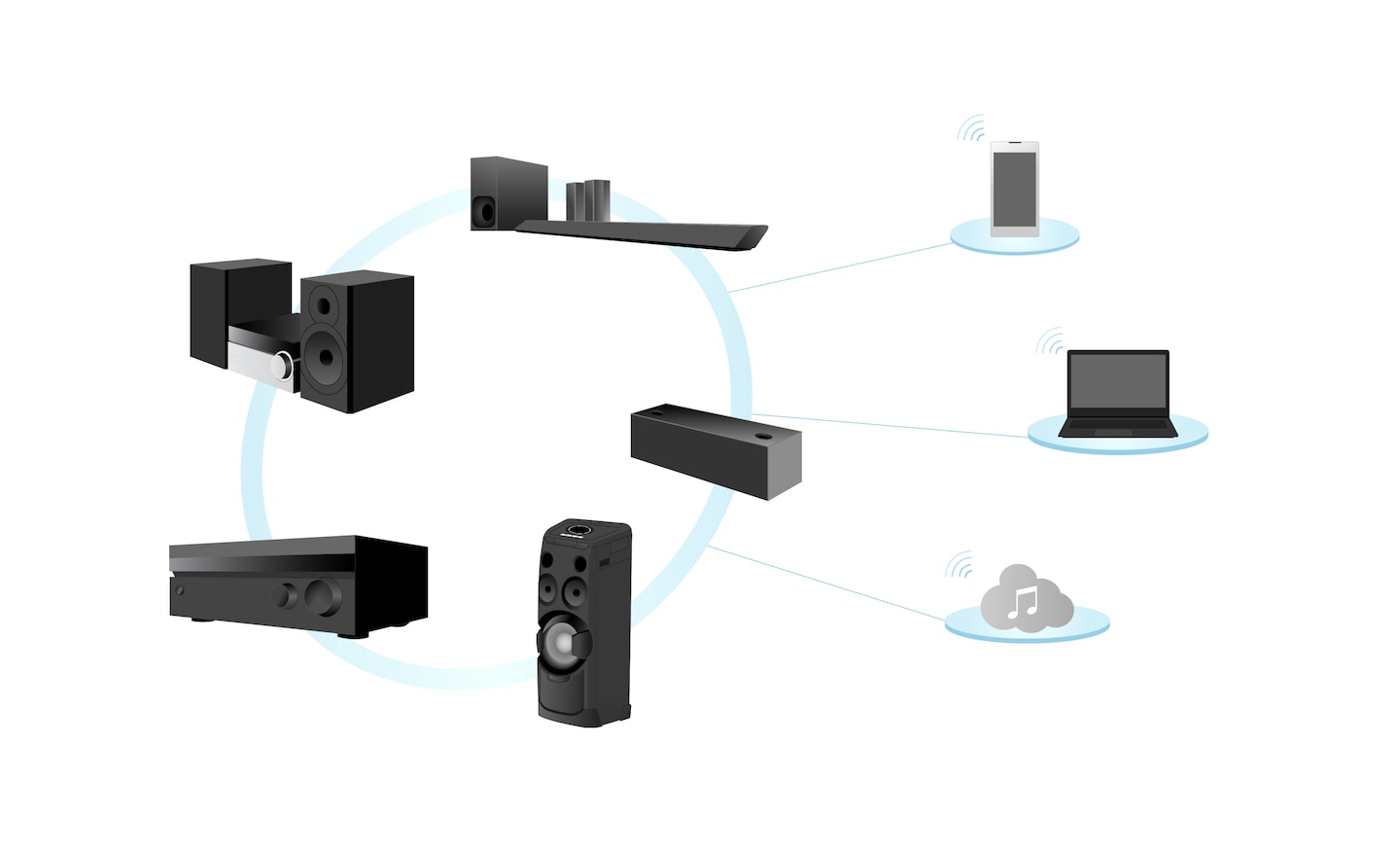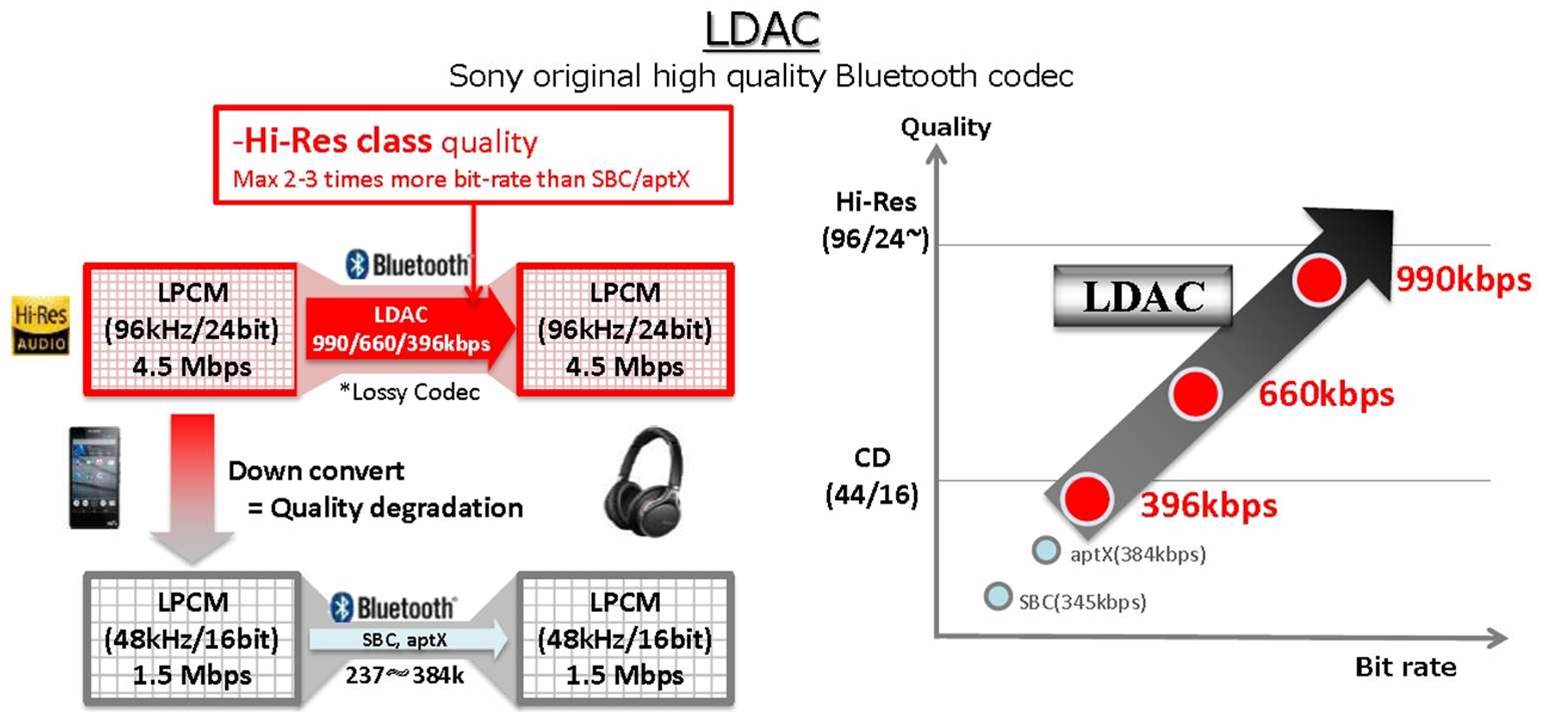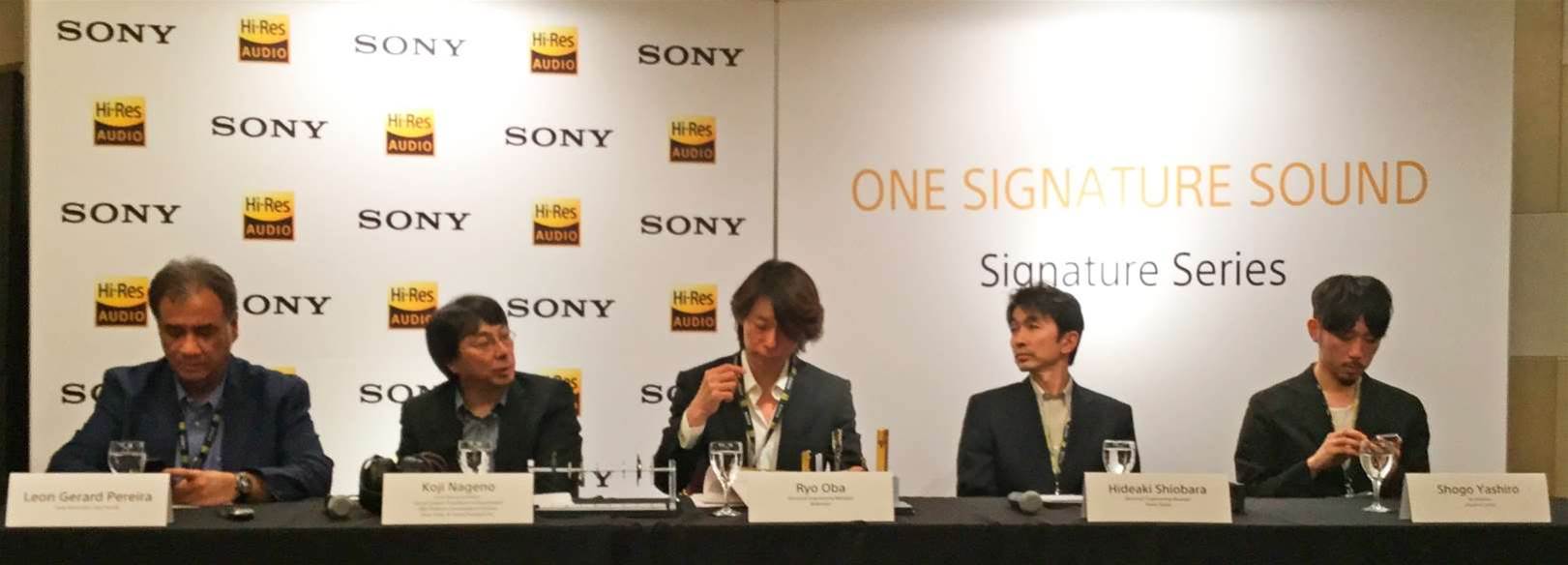Some uncomfortable truth about LDAC

This article is a continuation of the discussion originated in the previous article .
As practice has shown, the work of the Sony marketing team has borne fruit - and the LDAC codec is gaining popularity in its Bluetooth implementation and has even won a number of fans.
Let's make it out, is it really that great?

Such a picture is the main trump card Sony in promoting LDAC. The company claims that with the help of this codec, it was possible to exceed the quality of sound transmission three times better than SBC and even aptX, while still using Bluetooth as a transmission technology, and at the same time transmit high definition sound.
Hmmm ...
In the beginning, let's focus on the basics of Bluetooth. I know that I have already written about this, but without remembering it, it is impossible to focus on what I would like to discuss.
Introduction and brief educational program
There are versions, profiles and codecs. So, your device may have Bluetooth version 3.0. The music profile in it is A2DP, as in all Bluetooth versions for many years. And inside the A2DP profile, you can use different music codecs (MP3, AAC, SBC, aptX, LDAC, etc.) to compress music files into bitrates that can be transferred via Bluetooth.
In the Bluetooth system, the sending device is often called SRC (source), and the receiving device is called SNK (sink).
The Advanced Audio Distribution Profile (A2DP) was developed over a decade ago. Prior to this profile, there was a so-called “voice transmission” (“voice layer”), designed for headsets and having a bandwidth of just 64 kbit / s. The rest of the Bluetooth was “data transfer” (“data layer”). Therefore, to improve the quality of sound (and especially for the transmission of stereo), A2DP was developed, the essence of which was in capturing some part of the bitrate intended for “data transmission” and adapting it for music.
There is also the Audio / Video Remote Control Profile (AVRCP), which works in parallel to provide control data transmission: volume changes, track switching, and so on.
What data transfer rate can A2DP get from the shared pool? In fact, there are no limitations in the current version of A2DP , however, there are recommendations, and as regards the SBC codec, they look like this:

Thus, at a sampling rate of 48 kHz, the maximum available value is 345 kbit / s, and in the case of 44.1 kHz - 328 kbps Since the quality of an uncompressed CD requires a stream at 1411 kbps, the above recommended bitrates are clearly lower than what is required to transfer uncompressed music.
Lossy vs Lossless
To reason further, it is important to distinguish between two types of compression - lossless and lossy. Both reduce the file size and, therefore, reduce the "load" on the bitrate. The names speak for themselves - with lossless compression, information is not lost, and the recovered file in the receiver is identical to the file in the source. Lossless compression reduces file size by defining patterns that can be described and transmitted faster than by sending the raw data itself. Speaking roughly, it is faster to say “in the file 1000 words“ hello ”in a row” than to say “hello” 1000 times. Information will be the same, the transfer will occur without loss, but with compression.
There is a limit on lossless compression, andVirtually all of the existing lossless codecs (Apple Lossless, FLAC, Ogg Vorbis) can achieve compression of approximately two times - and no more . This value depends on the type of content and method used.
Lossy compression reduces file size by discarding bits. Loss codecs search for information that, in their opinion, you do not hear, then delete it in the hope that you will not feel the difference. With this approach, there is no limit to what degree of compression is possible to achieve - just more information will be thrown away. The MP3 128k compresses the CD about 13 times. Part of the compression is provided without loss, as mentioned above. All the rest is discarded data. And no matter what software or hardware innovations the manufacturer declares - you will never restore what was thrown, it is like repainting a black and white photo back.
Well, this is, in any case, in theory and logically.
aptX
Bluetooth A2DP profile is allowed to use different codecs. In fact, you can even use MP2, MP3, WMA, AAC and ATRAC - however, support for one codec is mandatory: SBC (Sub-Band Codec). This codec supports mono and stereo streams at various defined sampling rates up to 48 kHz.
All other codecs are optional (including the Sony ATRAC family), and companies can even define their own codecs. BUT: for successful operation it is necessary that the SRC and SNK devices have pre-installed support for these codecs.
Consequently, aptX, which is claimed to be “the highest quality widespread Bluetooth codec,” will work only if both devices are compatible with aptX — for example, your smartphone and your Bluetooth speaker.
Compatibility with aptX requires the manufacturer to pay a license fee to be paid to the owner of aptX (CSR / Qualcomm). Well, this has already been written in the previous article, but note that until recently, Apple included aptX only in small MacBook series, and Android devices received support for aptX only from the seventh version of the operating system (aptX HD - from the eighth) - moreover, In this version for some devices support has been disabled at the software level. It is clear that a large number of manufacturers of SNK devices — wireless speakers, sound panels, and so on — do not even think about this support, especially when it comes to low-cost technology.
Regularly, aptX is claimed as “CD quality,” but this is not true because it is limited to 328 kbps over the A2DP profile, although it is often stated that it reaches 384 kbps. As we remember, lossless compression provides a maximum double payoff, therefore, 384 kbit / s are transformed at best to 768 kbit / s, and it is obvious that aptX does not reach the required for “CD quality” stream at 1411 kbit / s, therefore, it is more correct to call it “quality close to CD” - in fact, comparable to 320 kbps AAC or MP3 files.
The already mentioned aptX HD codec deserves special attention. In fact, this is the same aptX, but with a different encoding profile and the possibility of a bit rate up to 576 kbps. And again, simple mathematics shows that this figure is not enough to “CD quality”, although it is already substantially close (1152 kbit / s).
Our findings are officially confirmed by Director Johnny McClintock (JM) - Qualcomm's Director of Marketing and Sales in an interview with Sound + Image (S + I) :
S + I: Can you confirm whether the aptX HD codec is lossless or lossy?
JM: Technically, aptX HD is a lossy compression codec. However, aptX HD uses a relatively soft compression ratio of 4: 1; it is not destructive in nature. Because it is based on adaptive differential pulse code modulation, rather than on the principles of psychoacoustic perception, aptX HD uses predictive analysis, rather than trying to reproduce the characteristics of human hearing through a synthetic ear.
S + I:Does he work in the A2DP profile or use additional data?
JM: The aptX HD algorithm uses A2DP for Bluetooth.
S + I: What is the maximum data transfer rate possible to achieve?
JM: To achieve 24-bit depth and to support a 48 kHz sampling rate, 576 kbps is required.
Thus, the aptX codec does not allow achieving “CD quality”.
Sony's LDAC
Part one. Story
In fairness, it should be said that Sony has already had and has Bluetooth solutions with non-standard codecs - these are Sony DR-BT50 headphones that support MP3 . There was also the Sony ATRAC codec, so familiar to everyone from long-forgotten minidisks.
But Sony Australia presents a novelty in the company's desire to enter the market of wireless audio solutions - the LDAC codec . The company simply called its decision “the Sony Multi-Room” system .

This system includes quite a lot: three wireless speakers, including one portable, plus one sound bar and one sound base, as well as the SX7 micro-Hi-Fi system. We also recommend the addition of one of the supported Sony AV receivers - STR-DN860 or 1060 models.
The capabilities of the resulting multi-room include high-definition DLNA streaming from 24 bit / 96 kHz to 24 bit / 192 kHz. In addition, there is Bluetooth, which uses Sony's own LDAC audio coding technology, which, according to the company, when you start playing high-definition audio via Bluetooth, provides a data transfer rate of 990 kbps .
In fact, there are three levels of LDAC operating at 330, 660 and 990 kbps - for the highest data transfer rate, you must select a mode with quality priority.
As with aptX, LDAC can only be used if the source and receiver device is equipped with LDAC. Currently, this list is quite small, moreover - quite expensive .
But back to the main question: how is this achieved using Bluetooth? As we have seen, the data transfer rate of 990 kbps is much higher than the specification of the entire Bluetooth A2DP stereo profile, not to mention the standard codecs in it.
Even if you leave it aside, it is unclear how the numbers are added. The CD quality stream on uncompressed 16-bit / 44.1 kHz has a data transfer rate of 1411 kbit / s. Thus, those specified in LDAC 990 kbps can easily use lossless compression to achieve full CD quality through LDAC. This is understandable.
But what about this high definition sound statement? Even if we talk about the lower limit of the declared 24-bit / 96 kHz - 24/96 stream should have a transfer rate higher than 4.5 Mbit / s. To get such a lossless quality with a bitrate of 990 kbps, you need a compression ratio of about 5: 1, which is more than twice as large as all known lossless codecs. That is, all the same codec compresses lossy data? But what then is the “high definition sound”?
Part two. Passion around Hi-Res Audio
Sound + Image contacted Sony Australia via e-mail and received confirmation that LDAC is indeed a lossy codec that uses data compression about 4.5 times - about half of which can be lossless (the very same 2!), The rest - with losses. In this case, the achievement of higher flow values is possible only through DLNA, but not Bluetooth.
But rather quickly, another e-mail with information from Japan followed, and then the correspondence broke out:
Sony: The information
provided to you earlier that LDAC is a lossy codec using data compression about 4.5 times is not valid .
The correct answer is: LDAC is a Bluetooth codec that uses more efficient data compression than regular codecs used in Bluetooth, such as SBC or aptX. Winning in compression can be up to 3 times.
However, while LDAC outperforms other Bluetooth codecs, it still compresses content. It should also be noted that the transmission of high-definition sound is possible through Wi-Fi. Our MultiRoon system supports a dual-band solution and in this case fully provides truly high-quality wireless audio.
We apologize for the conflicting information.
S + I:
We are sorry, but we understand that high definition audio can be transmitted via Wi-Fi. However, Sony's materials on LDAC clearly show high-quality, 24/96 quality audio transmission, which requires a transfer rate of 4.5 Mbps over a 990 kbit / s Bluetooth channel. Not Wi-Fi, Bluetooth! We attach a screenshot:

Please answer the question: when transmitting audio 24/96 via Bluetooth, is compression with loss or lossless used?
Lossless compression means that the original data can be completely and perfectly restored. Reducing the stream at a speed of 4.6 Mbps to 990 Kbps without a loss would be a huge achievement - no other known codec can achieve this value in real time.
Thus, we see three possible options:
a) Sony has a wonderful lossless compression system with a factor of 4.5x;
b) LDAC - lossy compression codec when sending 24-96 via Bluetooth;
c) the website and published materials are erroneous, and LDAC cannot send high definition audio via Bluetooth at all, only via Wi-Fi.
Sony:
Again, we apologize for the contradictory answers. In fact, your question is quite complicated, and therefore our experts are divided in opinions.
In order to clarify the situation, we invited Andrew Hughes, and he said that the situation is closest to what you stated in option a), although we would not like to use the word “wonderful.”
To help illustrate.
Consider the scenario in which you send high definition sound from an LDAC Walkman to an LDAC headset:
- To transfer over the air via Bluetooth, the file is compressed for transmission, and then at the other end, the headset reconstructs / unpacks the file to result in music equivalent to 96/24 .
- It makes a signal without loss, while the quality of the music is not lost. Lossy compression, on the other hand, compresses a file for transfer, but does not restore it at the other end, so the quality is more like an MP3.
- File transfer in such a scenario is possible for high-definition sound with 96/24 characteristics. The next level of detail, 192/24, in our scenario, will result in a loss of quality to a level equivalent to 96/24. LDAC cannot transmit quality higher than 96/24.
Thus, Sony announces its lossless compression system, capable of achieving a ratio of more than 4: 1.
The correspondence took place in 2015, and we must pay tribute to the corrosive guys from S + A –– a year later they met with Sony during the IFA 2016 in Berlin.
“This is not high definition sound, ” a Sony engineer from the Asia-Pacific region said. “ We do not claim that this is a high definition sound, but it is close to a high definition sound.”
The engineer wasn’t able to unambiguously tell whether the codec is related to lossless or lossy, but emphasized that Sony is always careful in its claim statements: in the latest materials, “LDAC effectively maintains the original bit depth and frequency of 24 bit / 96 kHz, providing more full and rich sound level Hi-Res Audio ". Very clever, is not it?
Regarding how Sony reduced the speed of 990 kbps LDAC to a much more limited A2DP channel, the engineer responded that LDAC increases the bitrate, and does not work according to the recommended A2DP specification.
Finally, the final answer to the question was obtained only at the IFA 2016 press conference in the Sound + Image conversation with the Chief Architect of Sony Audio Technologies (main specialization is headphones) Koji Nageno (KN). This is truly epic:

S + I: We like that Sony has been paying so much attention to the high definition sound in all its products since 2013, right up to the headphones, this is really great! But it seems to us that the term “high definition sound” is often used in the wrong sense. For example, the headphones MDR-1000X - in the brochures it says “hi-res audio”, there is the Hi-Res Audio logo, but if you read carefully, it turns out that in fact the sound is “almost” high definition. Can you explain how, for example, these bluetooth headphones can reproduce high definition sound?
KN:As for Bluetooth, it is limited by the transfer rate, it is 1 Mbps, so it is impossible to transmit a signal without some lossy compression. But LDAC is a codec very close to transmitting high definition audio. But we avoid saying “this is Hi-Res Audio”, yes, we are avoiding.
S + I: But how to explain the Hi-Res Audio logo and specification?
KN: With a wired connection with an analog input, the MDR-1000X can operate in “NC on” mode with high definition sound. But we are not saying that this is achievable with a wireless transmission, right?
S + I:Thus, the LDAC speed, as you say, is 1 Mbit / s, 990 kbit / s, but for 24/96 it takes 4.5 Mbit / s, which is four and a half times higher. With lossless compression, you can get perhaps 2 Mbps to work at 990 Kbps, but you are still more than halfway from high definition sound. How is this “very close to high definition sound transmission”?
KN: Maybe it’s really 100% unreachable with the current bitrate. It is necessary to look for ways to increase the bit rate or increase the lossless compression ratio in the codec. But yes, at the moment it is unattainable.
S + I: That is, it is not “close” to the high definition sound, is it 50% lower than the high definition sound?
KN:The quality of the sound itself is checked mainly ... well, you can evaluate the quality of music, listening to it, you can also evaluate the spectral shape of the waves. These are different things, but we check the sound quality - and we don’t see any difference. If you use the full bit rate, the maximum sampling rate and the maximum bit depth - we get a huge amount of information, but still we will not reach the ideal. When we listen to music at parties - is there no loss there? Although for high-frequency sounds, bit-depth speculation can indeed lead to lower quality. In any case - I can not say how many percent we are close to high definition sound. The sound quality is good, tests with listening and spectral waveforms pass - there is no difference.
[Other journalists ask questions.]
S + I:As engineers, you talk a lot about the purity of sound and in particular about the purity of high definition sound. So, how can you comment on the statement that any music file can be enhanced to almost the level of high definition sound? Do you believe in that? (This statement was made regarding the Sony DSEE (Digital Sound Enhancement Engine) HX used in Sony HDR-1000 headphones).
KN: As I have already explained, our experience, our test methods, the shape of the wave, and listening to the musical image reveal no differences. But if we remove the high frequencies and compare the sound - the difference will be obvious. So we think it’s close to high definition sound.
S + I:So if we can improve the quality of any file to high definition sound, we don’t need a high definition sound source at all?
KN: Uh. [Pause.]
S + I: Obviously, you can. It means that you can increase the quality of MP3 to high definition sound - and not hear the difference. Then we don’t need high definition sound at all.
KN: It depends on the original sound quality. Of course, if the original MP3 bit rate is too low, the quality cannot be improved. But we can improve it to some extent.
S + I:So which file can you enlarge to almost high definition? What level - 256, 320, CD quality? In which file you can not hear the difference? Your statement essentially buries the need to store high definition sound.
[Long group discussion.]
KN: Sorry. DSEE HX improves the sound, but the original bitrate should be 248 kbps. Then it can be improved to almost high definition. So, if the original sound source is lower, it cannot be upgraded to this level.
S + I: Wow! So Sony thinks that 256k can sound like high definition sound?
KN: Yes, almost like high definition sound.
A curtain. And my applause Sound + Image. Doge.
Part Three About generosity
In 2017, Sony's generous “sacrifice” became known, which made the use of LDAC technology free on Android O, in order “to be of great benefit in expanding the list of available smart devices that can send data using LDAC”. However, as correctly noted by Trusted Reviews , it is extremely unlikely that other acoustic manufacturers, other than Sony itself, will be so interested in licensing LDAC in their headphones - in principle we see this in the example of aptX / aptX HD.
Therefore, many phones may be ready to use LDAC, but to play it in “almost high definition” you only have to buy Sony headphones - in this case, the “victim” is quite justified!
In conclusion
Bluetooth version 5.0, however, does not include references to higher-speed audio in its standard equipment, despite a significant increase in data throughput . So the transfer of high-quality sound will still depend on the codecs.
Looking at the artificial limitation of the SBC bitrate, the aptX licensing schemes and the passion around LDAC, you think about a lot ...

